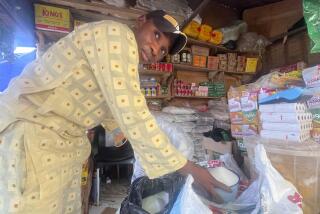Cuba Seeks to Break Sugar Habit by Retraining Industry Workers
- Share via
SAN CRISTOBAL, Cuba — In the cloying tropical heat of Pinar del Rio province, the “national garden” where jungles of sugar cane sag under their own weight, central planners are cultivating an economic revolution.
Sugar has been Cuba’s dominant crop and a vital source of dollars for two centuries. But dependence on one product has sickened a national economy already suffering from U.S. trade sanctions and the loss of trade when the Soviet bloc collapsed more than a decade ago. Tumbling world sugar prices have forced those governing this last flickering light of communism in the West to engineer an exit from their sugar addiction.
Cuban authorities have closed half of the country’s 154 sugar factories this year and have sent the first of an expected 200,000 idled cane cutters and mill hands to be retrained for work in greener pastures.
Independent economic analysts predict that the undertaking will fail. Cuba still is reeling from the loss more than a decade ago of Moscow’s subsidies, and the most promising opportunities -- in tourism and biotechnology -- are limited by a worldwide economic downturn.
To take what amounts to one in every 20 Cuban laborers out of productive work during an expensive conversion, analysts say, smacks of the outsized defiance of reality exhibited decades ago when Soviet leaders attempted to reverse the course of Siberian rivers and flood deserts in order to plant cotton and corn.
Sugar production has been on a downhill slide since 1970, when President Fidel Castro’s drive to harvest 10 million tons fell short by a million despite conscription of every able-bodied worker available to cut cane. Since then, output has eroded, to 4 million tons last year.
Even when sugar was fetching 12 cents a pound a few years ago, Cuba was spending at least 25% more on production than it was getting back in sales. Today, with the world overstocked with sugar to the tune of six months’ demand, Cuba spends about 17 cents a pound making a product that sells for only 5 cents a pound.
The rush of good money after bad prompted a government edict in May to retrain sugar workers for jobs in forestry, fruit and vegetable production, food processing and horticultural science. Planners hope they can reduce the country’s dependence on food imports, which costs the cash-strapped regime $1 billion a year.
“It’s never good to depend on just one product, which is why we need to diversify,” said Jose Luis Rodriguez, head of business and international relations at the Ministry of the Sugar Industry.
Agricultural engineer Oscar Almazan contends that Cuban researchers are perfecting the use of sugar cane as animal fodder. That would boost meat production and avoid waste of cane output, he said, calling the sweet feeds a promising “staple of the tropics.”
Those with a hand in the retraining effort also point to Cuba’s generally well-educated workforce as a reason for optimism in the daunting transformation. Cutters can just as easily harvest corn or cabbage, they insist, touting the community-based labor market as an attraction for foreign investors.
In fact, sugar workers are not so much based in their communities as bound to them. Prohibited by the regime’s anti-ownership ideology from selling or renting their state-owned homes or from buying cars that would allow them to commute, idled workers could not easily take jobs in another market even if they were being offered.
Developed along the Soviet model of horizontal integration, the sugar industry is mostly situated in remote company towns such as San Cristobal, where kindergartens, clinics, housing and all other services are provided under the factory umbrella. Castro has vowed to close the plants while maintaining salaries and services that made production a losing venture. Cuban economists such as Tirso Saenz Coopat insist that the regime can find a way to square the economic logic.
“We are driven by necessity. We can’t do anything with our industrial architecture without a market, and there is no market for sugar at the moment,” said the economist, who heads the state Assn. of Sugar Technicians.
Saenz cites soaring maintenance costs for idled mills as justification for shutting them down and stripping them of equipment that can be used elsewhere.
Rodriguez, from the sugar ministry, notes that the shuttered mills contain some of the most powerful generators in Cuban industry and can be tapped to supply electricity to counter the island’s frequent blackouts. And for every $35,000 boiler the state can avoid buying for the mills in the future, five greenhouses can be built to grow vegetables and flowers -- products impossible to import at affordable prices, he added.
With the country already on its economic knees, however, independent economic analysts say they see no way the regime can afford to finance its projected three years of downtime for former sugar workers.
“The retraining program is an intelligent effort by the government of Cuba to restructure, but it does have substantial short-term and medium-term costs,” said John Kavulich, head of the U.S.-Cuba Trade and Economic Council in New York. “These people won’t be productive while they are learning new skills.”
The intellectual transformation will be even more trying.
“Sugar workers are generally unskilled laborers,” the analyst said. “Some individuals are just not going to be capable of making the transition.”
One of 71 complexes surviving the mass shutdown, the 30th of November plant here in San Cristobal stands in grimy tribute to the corroded state of the industry. Rusty screws protrude from corrugated aluminum walls. Uneven concrete floors are safety minefields, strewn with stray electrical cords, loose parts from crumbling machinery and singed pieces of cane stalks. A rickety catwalk missing half its handrails traverses the grime-encrusted production line, which looks capable of making only smoke and noise.
At the Eduardo Garcia Lavandera agro-industrial complex, an hour’s drive west of here, two dozen workers huddle at tiny desks on a patio of the hacienda seized from sugar magnate Julio Lobo after Cuba’s 1959 revolution. The two personal computers set up yards away, like alabaster busts in an art museum, are of no use because the complex has been without electricity since morning.
If any of the workers doubt the viability of the transition, they are loath to say so. Others continue to trust their fate to the faltering revolution.
“We have security in our social system, so I’m not afraid of changes,” said Rosario Soca, a 40-year-old mother of two who has worked at the factory for 20 years and takes home less than $10 a month in pay. “Even if something happens, I will still get my salary.”
More to Read
Sign up for Essential California
The most important California stories and recommendations in your inbox every morning.
You may occasionally receive promotional content from the Los Angeles Times.











